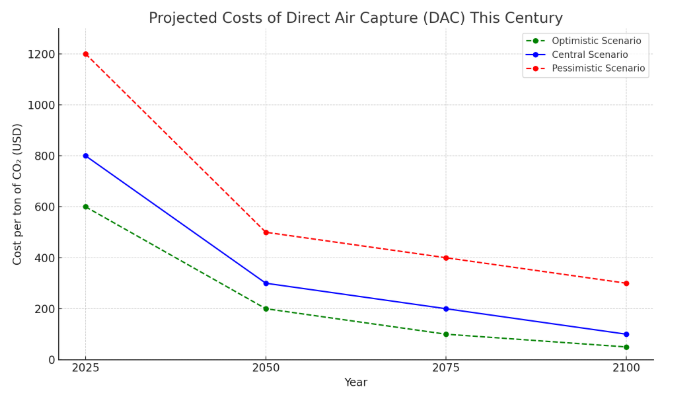
The cost of Direct Air Capture (DAC) this century is expected to vary significantly depending on technological advancements, policy support, energy prices, and deployment scale. Here’s a breakdown of current estimates and projections:
Climeworks (Switzerland): $600–$1,200 per ton of CO₂
Carbon Engineering (Canada): $94–$232 per ton (as of 2018; more recent estimates tend toward the upper range when all costs are included)
Global Thermostat: Similar range, though details are less transparent.
These numbers reflect early-stage, small-scale facilities. Costs include capital, operational, and energy inputs.
According to various sources including the IEA, IPCC, NASEM, and academic studies:
Optimistic scenarios (with
strong policy support, low-cost renewables, and economies of scale):
$100–$300 per ton of CO₂
Conservative projections:
$300–$500 per ton
High-end scenarios (slower
innovation, expensive energy inputs):
$500+ per ton
If DAC is widely deployed and benefits from scaling, modular design, and energy cost reductions (e.g. via cheap solar/wind or nuclear):
$50–$150 per ton of CO₂ (best-case scenario)
If decarbonization progresses unevenly and DAC remains niche:
$200–$400 per ton, or higher
Energy source: DAC is energy-intensive; cheap, clean electricity is essential.
Scale: Larger deployment lowers unit costs.
Technology choice: Liquid solvent vs. solid sorbent systems differ in capital and operating costs.
Location: Proximity to sequestration sites or CO₂ utilization hubs affects cost.
Policy incentives: Carbon pricing, tax credits (like the U.S. 45Q), and grants dramatically influence viability.
NASEM (2021): "Accelerating Decarbonization in the United States" – gives DAC estimates around $100–$300/tCO₂ with potential for lower in long term.
IEA (2022): "Direct Air Capture" technology report – projects similar long-term costs.
Keith et al. (2018): Carbon Engineering’s peer-reviewed estimate of DAC cost around $94–$232/tCO₂.
Realmonte et al. (2019, Nature Communications): Modeling shows costs vary dramatically depending on deployment and policy.